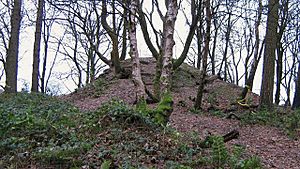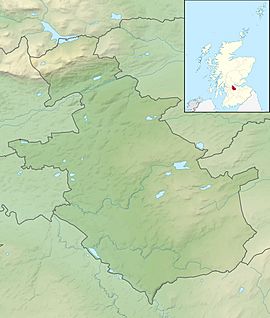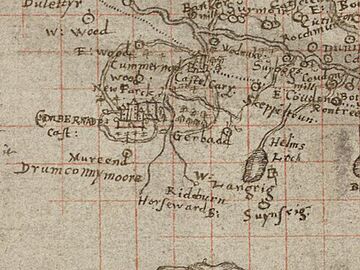Cumbernauld Castle facts for kids
Quick facts for kids Cumbernauld Castle |
|
|---|---|
| Cumbernauld, North Lanarkshire, Scotland | |

The Comyn Motte at Cumbernauld Park
|
|
| Coordinates | 55°57′43″N 3°57′51″W / 55.961920°N 3.964127°W |
| Site information | |
| Condition | Ruined |
Cumbernauld Castle was an old castle that stood where Cumbernauld House is today. You can still see the mound (called a 'motte') from the very first castle. Some stones from the second castle were even used to build the current house!
Contents
The First Castle: Comyn's Stronghold
The first castle at Cumbernauld belonged to the powerful Comyn family. After Robert the Bruce defeated John 'the Red' Comyn in 1306, the castle was given to the Fleming family.
This early castle was a Motte and Bailey design. This means it had a large earth mound (the motte) with a tower on top. Below the motte was a walled courtyard (the bailey). You can still see the motte in Cumbernauld House Park, a short walk northeast of the house.
The Fleming Castle: A Growing Home
When the Fleming family built their castle around the late 1300s, Scotland was not very rich. So, they probably started with a strong stone tower. This tower would have been "L-shaped," like a rectangle with a wing sticking out. Over time, as the Fleming family became more important, they added more stone buildings. These included a great hall for parties and important meetings.
In 1544, during a conflict called the War of the Rough Wooing, an English visitor named Edmund Storey came to the castle. He was surprised by how welcoming Lord Fleming was. Lord Fleming told him he would rather see his castle destroyed than let any harm come to his guest.
The castle stood where Cumbernauld House is now. Even though the original tower is gone, you can still spot some of its old stones in the walls of Cumbernauld House. Part of the castle's old courtyard walls are also still standing today.
Royal Visits and Tragic Events

Cumbernauld Castle welcomed many important guests, including Scottish royalty. King James IV often visited the castle. He was very fond of Margaret Drummond, whose sister was married to Lord Fleming. Sadly, Margaret and her sisters died mysteriously. They are buried in Dunblane Cathedral. These events made King James IV visit Cumbernauld even more often. On one visit, Margaret Tudor, King Henry VIII's sister, came with him.
Mary Fleming was one of the famous "Queen's Maries," who were companions to Mary, Queen of Scots. Mary Fleming and her brother, James, Lord Fleming, went to France with Mary, Queen of Scots, in 1548. In 1558, Lord Fleming helped arrange the Queen's marriage to the French Dauphin. Sadly, Lord Fleming and other Scottish officials died on their way home. Many suspected they were poisoned.
Mary, Queen of Scots, herself visited Cumbernauld Castle. She even planted a yew tree at Castle Cary Castle, which is still growing today. A scary event happened on January 26, 1562, while the Queen was staying at the castle. The great hall collapsed, and seven or eight men were killed. Luckily, the Queen was out hunting and was not hurt. She visited the families of those who were injured or died in the nearby village.
In 1640, eighteen Scottish noblemen met at Cumbernauld Castle. They signed the Cumbernauld Bond, agreeing to oppose the policies of the Earl of Argyll. The castle was later attacked and mostly destroyed by Oliver Cromwell's General Monck in 1651. Records also suggest the old castle was burned down by Highlanders during the Jacobite rising of 1715.
Caledonian White Cattle
During Queen Mary's visits, the park around the castle was home to deer and wild white cattle. These special white cows were unique to this area. John Lesley, a Scottish bishop, wrote that "this kind of kye [cows] and bullis has been for many years in the said forest, and the like was not maintained in any other part of this Isle of Albion."
The historian Hector Boece also wrote about the Caledonian white cattle at Cumbernauld in 1527. A Swiss scientist, Conrad Gessner, even included a drawing of these cattle in his book in 1554. The picture was sent to him by a Scottish friend, Henry Sinclair.
Archaeological Discoveries
After the new Cumbernauld House was built in 1731, the old castle was turned into stables. However, it was burned down by soldiers in 1746. You can still see one of the original castle walls in the allotment area today.
In the 1960s, local historical and archaeological groups started digging around Cumbernauld House. They found parts of the castle's service areas. These included a 15th-century rubbish chute, a prison, a cellar, and a well-house with steps. Later digs in the 1980s uncovered a cobbled courtyard and the base of a round building. These areas have since been filled back in to protect them.
Images for kids





